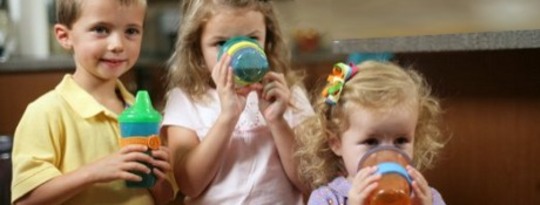
More than one in ten children under the age of three have tooth decay according to statistics published by Public Health England. The figures show that an average of three teeth in these children were decayed, missing or filled. This is shocking, although not surprising considering children of all age groups exceed the the current recommendations for added sugar.
The World Health Organisation recommends we limit our sugar intake to 10% of our total calorie intake a day because of the negative effect that sugar has on our health. Boys and girls around the age of three require around 1,100 calories a day, which means no more than 5.5 teaspoons of added sugar to their daily diet. This may seem a lot but the figure is likely to soon be halved by the Scientific Advisory Committee on Nutrition (which advises on public health in England), limiting intake of added sugar to just 5% of calorie intake.
According to the latest survey of national diet and nutrition, children and teenagers consume around 40% more added sugar than the recommended daily allowance. And fruit juice and soft drinks are the main culprits.
Why Fruit Juice Isn’t So Innocent
Fruit juice has had to bear the brunt of a large amount of negative press recently. Although fruit juice is rich in “natural sugar”, sugar is sugar as far as the body is concerned. The sugar content of a glass of apple juice is not much different to that in a glass of cola and the damage it can cause to teeth is massive.
We are constantly reminded that fruit juice contributes to one of our “five-a-day” of fruit and vegetables and clever marketing means it looks like one of the healthiest options – but unfortunately it isn’t. Current advice is to consume no more than 150ml of fruit juice per day. This is equivalent to around two and a half oranges. I doubt a young child could eat this many oranges so they should not drink that amount of juice (or sugar) instead.
Fussy eating phases commonly start around the age of two so drinks are often seen as an easy way to get at least some fruit into children. Of course fruit juice tastes nice and sweet so it will appeal to a child, which makes it difficult for children to accept water instead. Whole fruit is much better in general, not just for teeth, because it contains fibre which slows down the absorption of sugar in the body and has added vitamins. Freshly pressed juice or juice with “bits” in is also preferable. If children do have fruit juice, dilute it by 50% with water and offer it at meal times only.
Juice drinks aimed at infants and toddlers are simply not necessary and only contribute to children developing a “sweet tooth”. Water and milk for the under threes are the best choice.
Drinking Vessels (Bottles & Sippy Cups) Make It Worse
Drinking juice from bottles and sippy-cups, particularly those with valves, increases damage to the front teeth because children often suck the drink and it gets washed over the teeth rather than going to the back of the throat. Some children also suck on bottles for comfort which prolongs exposure to the sugar.
Once a child reaches a year old, they should be encouraged to start drinking from a cup. Introducing a non-spill cup at meal times when you begin weaning can make life a lot easier when making the transition to an open cup later on. Many children can find this transition difficult (as can parents) because the bottle is often a great source of comfort and less messy but the later you leave it the more resistance you may experience.
Although breastfeeding may continue well beyond one year old, moving away from a bottle will also help children develop important co-ordination skills. They will eventually learn how to control the cup without spilling the contents and of course this will help protect their teeth too. It can be useful to teach your child to sip drinks through a straw. This limits the exposure of any sugars onto the teeth surfaces as the drink is drawn towards the back of the mouth and children often enjoy drinking this way.
Children are attracted to bright, sugary drinks but as the evidence and the public health figures show, too many are suffering damage. Tooth decay before the age of three is avoidable.
This article was originally published on The Conversation.
Read the original article.
About the Author
 Melanie Wakeman specializes in nutrition and has been teaching nutrition since 1996. Currently she is the Programme Director for the BSc. (Hons) Health and well-being (Nutrition Science) at Birmingham City University (BCU).
Melanie Wakeman specializes in nutrition and has been teaching nutrition since 1996. Currently she is the Programme Director for the BSc. (Hons) Health and well-being (Nutrition Science) at Birmingham City University (BCU).
Disclosure Statement: Melanie Wakeman does not work for, consult to, own shares in or receive funding from any company or organisation that would benefit from this article, and has no relevant affiliations.
Recommended Book:
The N.D.D. Book: How Nutrition Deficit Disorder Affects Your Child's Learning, Behavior, and Health, and What You Can Do About It--Without Drugs
by William Sears, MD
 N.D.D., or Nutrition Deficit Disorder, as coined by Dr. Bill Sears, is based on the idea that if "you put junk food into a child's brain, you get back junk behavior and learning." Dr. Sears explores the latest scientific research on the effects of nutrition on the brain. Instead of simply medicating his patients, Dr. Sears looked for a better solution--in fact, with better nutrition, many of his patients were able to greatly reduce or even stop their medication. The book will provide parents with a prescription, shopping and meal tips, and recipes to make implementing a healthier lifestyle that much easier.
N.D.D., or Nutrition Deficit Disorder, as coined by Dr. Bill Sears, is based on the idea that if "you put junk food into a child's brain, you get back junk behavior and learning." Dr. Sears explores the latest scientific research on the effects of nutrition on the brain. Instead of simply medicating his patients, Dr. Sears looked for a better solution--in fact, with better nutrition, many of his patients were able to greatly reduce or even stop their medication. The book will provide parents with a prescription, shopping and meal tips, and recipes to make implementing a healthier lifestyle that much easier.
Click here for more info and/or to order this book on Amazon.






















